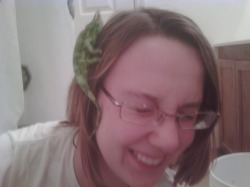Our Collection
Our personal collection of Pythons, Boas, Colubrids, Amphibians, reptiles, etc.
Saleen and Roush- Ball Pythons
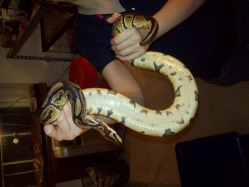
Our two Ball Pythons- our first snakes, and two of our favorites :) We strongly recommend Ball Pythons as pets for first time snake owners, as their docile nature and fair size make them easy to care for and to live with, while retaining an impressive stature.
Vlad and Sangria- Blood Pythons
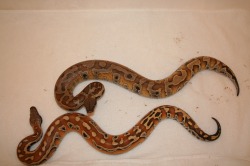
Merlin and Raven- White Lipped Pythons
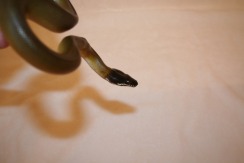
Medusa- Pueblan Milk Snake
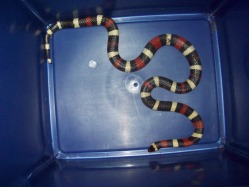
Medusa is a Pueblan Milk Snake, and is another easy keeper- full of energy, extremely curious, and FAST, the Pueblan Milk Snake isn't as easy to keep up with as the Ball Python, but its beautiful coloration and simple needs make it another top choice for the new herper.
Spitfire- Albino Honduran Milk Snake
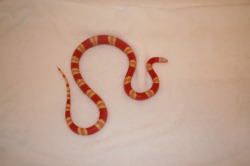
Voodoo- Jungle Carpet Python
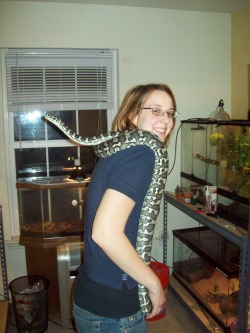
The Carpet Python isn't terribly difficult to keep IF you have the space for a 6-8 foot long snake. Voodoo is content in a 50 gallon terrarium as long as he is allowed out to explore (under supervision, of course) fairly regularly. Voodoo was someone's pet for a number of years, until he got too big for their tastes- a fate far too common for many reptiles. He's been an absolute joy to keep, and never fails to make us smile. Having Voodoo is what inspired us to continue acquiring Carpet Pythons in different variations, and led to the creation of our business. The Carpet python has been combined and hybridized with many other species of Python, most notably the Green Tree Python (or 'Chondro') which we will explore next!
Mystique- Green Tree Python
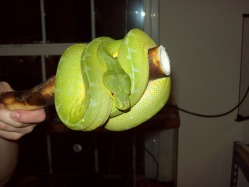
Mystique is a Green Tree Python, and is quite docile for her species. She, along with Esmerelda, are living proof that most snakes can be acclimated to regular handling, even those whose natural territory takes them far from the world of man. Green Tree Pythons are arboreal, living most of their lives in trees, but have been known to come down and forage for food at night when none is available to them otherwise. Their species has a reputation for being difficult to care for and handle, but we have been extremely fortunate to have such a sweetheart in our collection. Mystique could be bred to a Carpet Python like Voodoo or Volt to produce a hybrid called a 'Carpondro' which seems to take the GTP's arboreal nature and combine it with the personality and markings of a Carpet Python- truly an interesting combination!
Esmeralda- Emerald Tree Boa
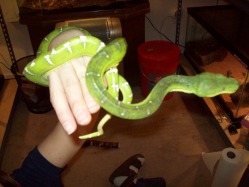
The Emerald Tree Boa, or ETB, was once thought to be the same snake as the GTP, but was later discovered to be an entirely different species adapted to the same environmental needs. While their colors are similar, their patterns and the shape of their heads are quite different- One would imagine the confusion was due to some measure of panic upon meeting these two species in the wild, as a most likely description of it would have been, "A bright green snake fell out of a tree on me!" The ETB is a Boa, and is therefore ovoviviparous, meaning it gives birth to live young. The GTP is oviparous, giving birth to eggs.
Volt- Jungle/Jaguar Carpet Python
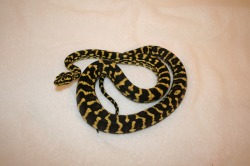
Volt is a recent addition to our collection, and his beautiful, vivid markings make him a sure winner for our future breeding plans. He is 75% Jungle, 25% Coastal Jaguar pattern Carpet Python. Like Voodoo, he will grow to be fairly large, most likely one of the largest we will have in our collection- As much as we like the Burmese Pythons, Anacondas, and Reticulated Pythons, we just don't have the room for a 20+ foot snake!
Rogue- False Water Cobra
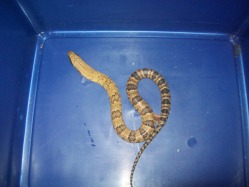
Rogue is a False Water Cobra, which come from South America. Though he has a 'hood' like a cobra, he is actually a Colubrid, related to King snakes. He is mildly venomous, but like Arnold, his venom is delivered via short fangs in the rear of his mouth, so it is primarily used to help overpower prey he has already caught. He can grow up to 10 feet long, and FWC's tend to be rather heavily bodied snakes, but a length of 6-8 feet is more likely. He doesn't like being surprised, but he's easy to handle once he is out of his cage. FWC's are omnivores, eating just about anything they can overpower- fish, birds, frogs, toads, small mammals... it's all good to the hood!
Arnold- Western Hognose Snake
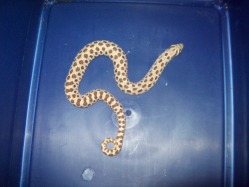
Arnold is from a very interesting breed of snake called the Hognose snake, which has a three step defensive process seen in almost every example of the species- Step 1: Puff up, making itself appear larger and hissing. Step 2: Make false strikes, with the mouth closed. Step 3: PLAY DEAD! Believe it or not, these guys have been known to play dead, lying on their backs with their tongues lolling out. They will even go so far as to turn themselves BACK over when righted, as if to say "No, really, I'm dead!" Arnold, like Rogue, is rear fanged venomous, meaning he 'chews' his venom into his prey to subdue it. He poses no real threat to humans due to the lack of potency of his venom and his docile (yet outwardly threatening) nature. The Hognose snake is so named because of its oddly shaped face, suited to digging into loose substrate to bury itself.
Magellan- Dumeril's Boa
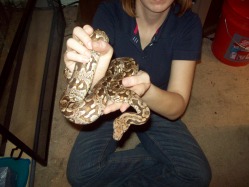
Magellan is our Dumeril's Boa, an even-tempered species from Madagascar. Although their natural habitat is threatened and their trade has been banned, the easygoing nature and beautiful patterns and iridescence of this species has ensured its survival in breeding programs throughout the world. Though not as common as Ball Pythons, they are also a great starting point for new herpers. They do require higher humidity levels than many snakes and prefer a bark substrate to bury themselves in, so they are a bit different to care for, but well worth the effort. Almost sinister in appearance, but you couldn't ask for a nicer snake to handle.
Picasso- Peruvian Rainbow Boa
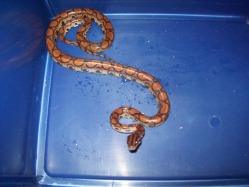
Picasso is a Peruvian Rainbow Boa, which are undoubtedly some of the most colorful and beautiful snakes in the world. There are several variations of the Rainbow Boa (Peruvian, Brazilian, Colombian, etc.) but all share an amazing amount of the iridescence that all snakes have inherent in their skin as well as astonishing patterns and colors. The Rainbow Boa requires a very moist environment, much like the ETB and GTP, and as such requires a greater amount of attention- not for inexperienced herpers, but certainly not out of reach for anyone who is willing to put in the time and effort to truly understand their needs and personalities.
Oscar- Roughscale Sand Boa
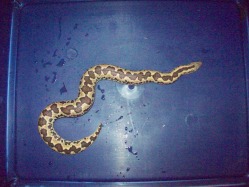
Oscar, so named for the Oscar Meyer weiner, is a Rough Scale Sand Boa. He likes to bury himself in his substrate with his head sticking out, waiting for prey to happen upon him. He is still a juvenile, and as such still tends to be a little bit nippy- for a fat little guy, he bites hard! This species is fairly sedentary, and seems reluctant to waste energy exploring during the day.
Ra- Solomon Island Ground Boa
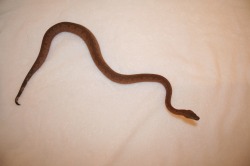
Ra is a Solomon Island Ground Boa, one of three species in the genus Candoia, which also includes Solomon Island Tree Boas. He is terrestrial, spending his time on the ground and hiding under light debris and in small holes. Species in the genus Candoia are exclusive to the islands of the South Pacific, and the ground boa is well adapted to such an environment. His upward slanted nose makes him a sure winner in the looks department, and his temperament couldn't be nicer. If you look closely, there is a muted pattern to his skin that is quite intricate!
Brutus-Colombian Red-Tailed Boa
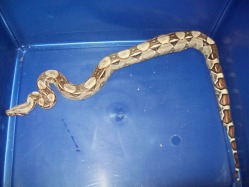
The Colombian Red-Tailed Boa is another common snake for beginners, due to its docile nature and exotic pattern, as well as its relative popularity among breeders, making it easy to find fairly cheaply. Unfortunately, one of the main attractions to this type of snake is also its biggest downfall- they grow quite rapidly, which a lot of people like (instant progress and all that) but they can grow to be quite large- many find themselves in rescues or released into the wild, where they usually perish due to conditions they did not evolve to survive. Remember: If you can't handle a 10-12 foot snake, this one isn't for you!
M.D.- Red African House Snake
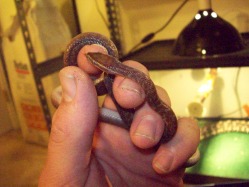
M.D., so named because she is a House snake (Get it? House, M.D.?) is a small colubrid, is extremely easy to care for, has almost no special requirements beyond heat, food, and water, and will most likely never outgrow a 10 gallon tank. The downside: Like Medusa, they are quite fast and eager to escape! As with any reptile, the SINGLE BEST thing you can do for their safety is to provide a secure enclosure! This keeps everything without opposable thumbs out (Cats, dogs, etc.) and keeps them in the safety of their enclosure. The house snakes make excellent beginner snakes due to their availability, price, limited space and heat requirements, and the fact that they are some of the cheapest to feed- remember, you can buy cheap snakes that grow large, but you'll spend more than the original cost just feeding them for a year! M.D. is an excellent example of a juvenile House Snake, and will soon grow into a beautiful adult.
Luigi- Pacman Frog
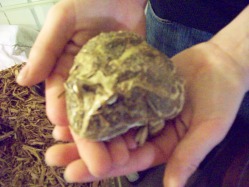
Meet nature's perfect eating machine. He's on that seafood diet you hear about- "see food, eat it!" He will consume like a drunken frat boy without the aftermath, and watch those fingers around his mouth! But hey- he's cute, right?
Ketchup- Red Spotted Tomato Frog
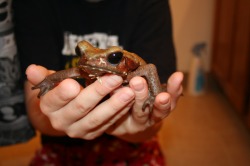
Michael and Janet- Jackson's Chameleons
